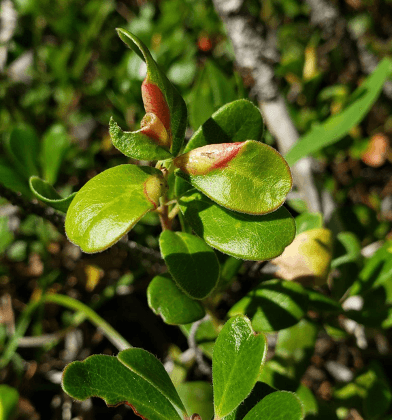The Gall of Kinnikinnick
By Stephanie Murphy
Broadcast 8.10 & 8.13.2022

Opening up a gall to examine the tiny manzanita leaf-gall aphids. Photo by Stephanie Murphy.
Listen:
In the back of a Forest Service-green pickup truck climbing a rutted dirt road in the Flint Creek Range near Philipsburg, I am reminded to drink more water. At about 6,000 feet of elevation, the drive includes beautiful vistas, terrifyingly steep drop offs, rusty old mining equipment, and late-summer wildflowers. Our goal for the day is to fill a Nalgene with huckleberries. The huckleberry patch occupies a steep slope with a patchwork of shade and sunlight passing through lodgepole pines.
Neighboring the huckleberries and the dirt road, we find kinnikinnick hugging the earth. This low-growing, woody shrub is one of the only Montana species in the genus Arctostaphylos, which includes manzanitas and bearberry (or kinnikinnick). The scientific name for kinnikinnick is Arctostaphylos uva-ursi, a deceptively repetitive name with Arctos meaning “bear,” staphylos meaning “bunch of grapes,” and uva-ursi meaning “grapes of the bear.”

The reddish-yellow growths on the edges of the kinnikinnick leaves are galls, where manzanita leaf-gall aphids make their homes. Photo by Stephanie Murphy.
We pause our berry gathering to more closely examine the kinnikinnick. On many parts of the shrub, the smooth, leathery green leaf margins are accented by bulbous, yellow-red growths. Unmistakably, these are galls, tumor-like growths of the leaf tissue. Each gall was induced by a manzanita leaf-gall aphid (Tamalia coweni), a female aphid who probes along the leaf to form a tiny home. Inside, this asexual female gives birth to live offspring produced through parthenogenesis: clonal reproduction through unfertilized eggs. Manzanita leaf-galls were the topic of my master’s thesis, which I defended not two weeks before our search for huckleberries.
The life cycle of the manzanita leaf-gall aphid often reminds me of a complicated set of nesting dolls. Inside one doll is another doll, filled with another doll, and another, and so on. For the aphids, there are typically four nesting dolls—four generations in a yearly cycle. In the spring, a female hatches out of an egg, induces a gall on a manzanita or bearberry leaf, and then gives birth to her offspring. These winged females grow and then emerge from the gall to fly off and find new leaf growth. They then give birth to their own female offspring who will induce galls and give birth to their offspring—this time winged males and females. They grow and then emerge from the gall to fly off and reproduce. Their resulting eggs overwinter and the cycle continues the following spring and summer. The timing of this life cycle goes hand in hand with the growing season of their host plant, in this case kinnikinnick, as galls are more readily formed on new growth leaves.
I open a gall with my fingernail and inspect the inhabitants. Sure enough, tiny manzanita leaf-gall aphids, about the size of a sesame seed, overflow from the small space. Each offspring is a variation of green-yellow, the gall-inducing female identifiable by her darker green exoskeleton. Inside the gall, the aphids are sucking up sap from the leaf tissue. These briefly inhabited galls are fairly messy from sticky honeydew, the sugary waste the aphids produce, as well as scattered exuviae (the shed exoskeletons from each molt).
Would I have noticed these galls if I hadn’t spent the last three years collecting, freezing, and dissecting hundreds of them? It’s probable that I will be joining ladybeetles and gardeners in aphid hell, pending the existence of Dante’s forgotten circle. Though many consider aphids to be a pest in their gardens, the manzanita leaf-gall aphids are loyal to their host plants within Arctostaphylos. The aphids exploit these plants as a home and a food source, but cause no major damage. I appreciate the beauty of the rich red galls that shine in a forest of deep green. These tiny creatures are not so different from us, sharing a cozy home and feasting on sugar through the summer.
Every week since 1991, Field Notes has inquired about Montana’s natural history. Field Notes are written by naturalists, students, and listeners about the puzzle-tree bark, eagle talons, woolly aphids, and giant puffballs of Western, Central and Southwestern Montana and aired weekly on Montana Public Radio.
Click here to read and listen to more Field Notes. Field Notes is available as a podcast! Subscribe on iTunes or wherever you listen to podcasts.
Interested in writing a Field Note? Contact Allison De Jong, Field Notes editor, at adejong [at] montananaturalist [dot] org or 406.327.0405.
Want to learn more about our programs as well as fun natural history facts and seasonal phenology? Sign up for our e-newsletter! You can also become a member and get discounts on our programs as well as free reciprocal admission to 300+ science centers in North America!












